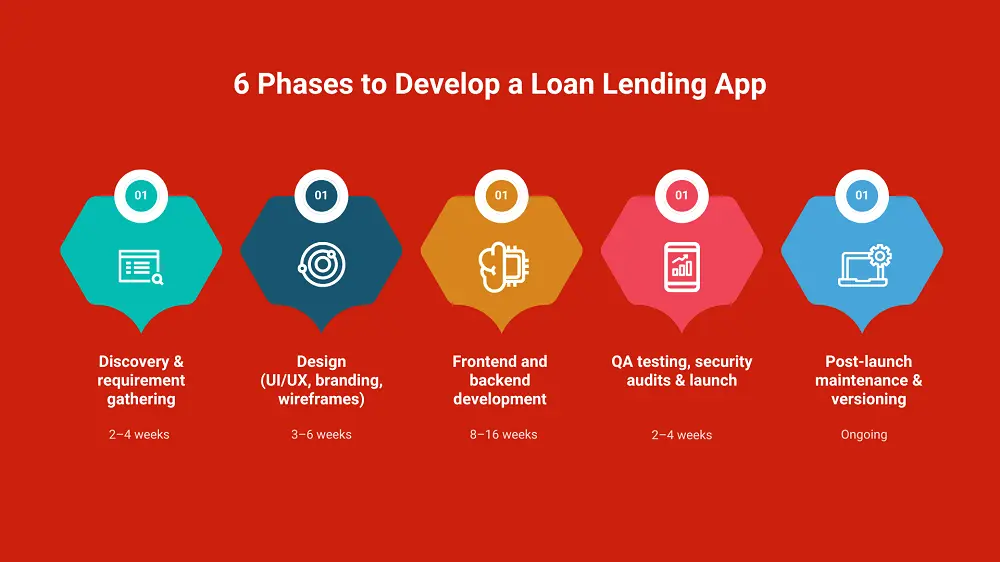The average loan lending app development cost in 2025
The cost of developing a loan lending app depends on the stage of product maturity, the complexity of features, infrastructure requirements, and compliance needs. In most real-world cases, development budgets are categorized into three main tiers: MVP, Mid-Level, and Enterprise. Each tier reflects a different level of business readiness, from initial validation to full-scale market deployment.
In 2025, development costs typically range from $30,000 for a lean MVP to over $300,000 for an enterprise-grade solution.
The table below outlines the typical scope, estimated cost, and development timeline for each tier in 2025:
| Scope | Team & Features | Estimated cost range | Estimated time |
|---|---|---|---|
| MVP | Core features (login, loan request, KYC, dashboard) with basic UI | $30,000 – $60,000 | 6–10 weeks |
| Mid-Level | Add repayment engine, analytics, notifications, user tiers | $60,000 – $120,000 | 10–16 weeks |
| Enterprise | AI scoring, regional rules, multiple user roles, custom design, scaling infra | $120,000 – $300,000+ | 16–24+ weeks |
The six primary cost drivers in lending app development
1. Platform choice
Platform choice plays a major role in loan lending app development cost. Building for Android, iOS, and web means separate code, testing, and deployment for each, raising complexity and expenses. Even with cross-platform tools like Flutter or React Native, platform-specific logic still requires extra work.
Most loan lending apps also need a web-based admin dashboard for reviewing applications, managing repayments, and monitoring risk. This dashboard functions like a separate product, adding to development time and cost. As a result, supporting multiple platforms can increase your total loan lending app development cost by 30–60%, depending on your tech stack, code reusability, and UI complexity.
Here’s a breakdown of platform development:
| Platform type | Estimated dev hours | Estimated cost ($50/hr) |
|---|---|---|
| Android/ iOS only (native) | 400–600 hrs | $20,000 – $30,000 |
| Web admin dashboard | 300–500 hrs | $15,000 – $25,000 |
| Cross-platform (Flutter/React Native) | 600–800 hrs | $30,000 – $40,000 |
While cross-platform tools offer time savings through shared code, they may limit access to native performance optimizations or complex animation capabilities that enhance user experience.
2. Feature complexity
Simple features like login or a loan calculator are quick to build and mostly rely on frontend logic. In contrast, advanced features such as KYC verification, AI credit scoring, or peer-to-peer lending require complex backend systems, third-party API integrations, and strong data security.
These features often involve multi-step workflows, admin control panels, detailed error handling, and compliance with financial regulations. The more business logic and security a feature needs, the more time and cost it adds to your loan lending app development.
| Feature example | Estimated cost |
|---|---|
| Login/Sign-up | $1,500 – $2,500 |
| Loan request form | $2,000 – $3,000 |
| Loan calculator | $1,000 – $1,500 |
| User dashboard | $2,500 – $3,500 |
| KYC integration | $3,500 – $5,000 |
| Admin panel with role control | $4,000 – $6,000 |
| Repayment history | $3,000 – $4,500 |
| Push/email notifications | $1,500 – $2,500 |
| AI-based credit scoring | $7,500 – $10,000 |
| Peer-to-peer lending engine | $6,000 – $9,000 |
| Biometric login (face/fingerprint) | $3,000 – $5,000 |
| Behavioral analytics | $5,000 – $7,500 |
3. Development team and location
Your development team’s geographic location affects your loan lending app development cost because labor rates vary widely between regions. Developers in different parts of the world charge different hourly rates based on local living costs, market demand, and average wage levels. In addition, teams in some regions may have extensive experience with fintech projects, allowing for faster delivery and better cost-efficiency.
Here’s a closer look at the typical rates and talent profiles by geography:
| Region | Hourly development rate |
|---|---|
| North America | $80 – $200 |
| Western Europe | $60 – $150 |
| Eastern Europe | $40 – $90 |
| India & Southeast Asia | $25 – $60 |
4. Design complexity and branding
A simple app using a pre-built UI template can be implemented quickly with minimal custom work. However, if your lending app demands a branded user experience with customized components, animated transitions, interactive dashboards, and responsive layouts across devices, then design time and frontend development increase sharply. Each additional user flow or screen variation requires design planning, component coding, and cross-device testing.
Financial apps also require clear visual communication for complex data like repayment schedules, interest rates, and user obligations, which increases UI complexity. Altogether, advanced design choices add hundreds of extra hours to the frontend workload and push total cost significantly higher.
| Design type | Scope | Estimated cost |
|---|---|---|
| Template-based UI | Standard layout, minimal customization | $3,000 – $6,000 |
| Custom UI/UX Design | Unique flows, responsive screens, full brand integration | $8,000 – $15,000+ |
| Advanced/Interactive UX | Data visualization, transitions, animations | $15,000 – $25,000+ |
5. Third-party integrations
Third-party integrations are a key part of loan lending app development, adding critical functions like KYC, payments, user notifications, and analytics. Based on our experience building fintech apps, these services require your team to set up API connections, manage authentication, handle errors, and sync data with your backend. They also add ongoing costs based on usage, which should be planned from the start.
Here’s a typical cost breakdown based on trusted tools used in lending apps:
| Integration | Integration cost | Ongoing/API fees |
|---|---|---|
| KYC (Onfido, Jumio) | $2,000 – $4,000 | $1–$3 per user verification |
| Payment (Stripe, PayPal) | $1,000 – $3,000 | ~2.9% + $0.30 per transaction |
| Messaging (Twilio) | $500 – $1,500 | $0.0075/SMS, pricing by usage tier |
| Analytics (Mixpanel, GA) | $1,000 – $2,000 | Free to $300+/month based on users |
6. Hidden costs
Beyond these above key factors, there are several essential costs that are often underestimated but can account for 20–30% of your total loan lending app development budget. Ignoring them can cause unexpected delays or compliance risks post-launch.
- Legal compliance typically adds $10,000 to $30,000. Your app must meet standards like GDPR, PCI DSS, and local lending regulations. This requires encrypted data storage, consent tracking, and audit logs, and secure backend infrastructure.
- Marketing and user acquisition features can cost $5,000 to $15,000. These include referral systems, push notifications, onboarding flows, and performance analytics. These require not just frontend interfaces but also backend logic and integration with third-party tools like email platforms and CRM systems.
- Post-launch maintenance usually takes up 15–20% of your initial build cost annually. After launch, your team will need to handle updates, bug fixes, security patches, compliance changes, and user support. Ongoing maintenance is critical to keeping the app reliable and secure over time.
- Scalable infrastructure adds another $5,000 to $25,000 upfront, plus monthly hosting costs. To support thousands of users and real-time loan processing, your backend must include auto-scaling servers, distributed databases, load balancers, and monitoring systems.
Pro tip: Planning for these “hidden” costs early helps avoid budget overruns and ensures a more reliable, scalable app in the long run.
Lending app development cost by phase
Another practical way to estimate your loan lending app development cost is by breaking it down by development phases. Each stage not only contributes to the overall timeline and budget but also plays a crucial role in ensuring the final product is robust, compliant, and user-friendly. Below is a detailed breakdown of each phase:

Phase 1: Discovery & requirement gathering
Duration: 2–4 weeks
Estimated cost: $5,000–$10,000
The discovery phase lays the foundation for your entire lending app project. This is where you define the scope, set business goals, and assess technical feasibility. Investing in this phase prevents costly missteps later by ensuring all stakeholders are aligned and requirements are clear.
Typical activities include:
- Conducting stakeholder interviews to align on vision and expectations.
- Compiling a comprehensive feature list based on market needs and regulatory requirements.
- Mapping out user flows and loan processing journeys.
- Planning for compliance with financial regulations (e.g., KYC, data privacy).
Phase 2: Design (UI/UX, branding, wireframes)
Duration: 3–6 weeks
Estimated Cost: $8,000–$20,000
Once requirements are clear, your product moves into the design phase. A well-structured design reduces user confusion, increases adoption, and minimizes future support costs. Investing in design upfront pays dividends in customer satisfaction and lowers the risk of expensive redesigns after launch.
This phase includes:
- Defining core user journeys for both borrowers and admins.
- Establishing a clear visual hierarchy and branded design language
- Creating wireframes and mockups for all major screens and workflows.
- Developing a design system for consistency across platforms.
- Ensuring mobile/web responsiveness for all device.
Phase 3. Frontend and backend development
Duration: 8–16 weeks
Estimated Cost: $30,000–$100,000+
This is the most resource-intensive phase, accounting for the majority of your development cost due to its technical complexity, regulatory requirements, and the need for secure, reliable infrastructure.
It involves:
- Developing the frontend: borrower dashboards, loan application forms, repayment schedules, and admin panels.
- Backend systems: KYC verification, credit scoring algorithms, loan processing, payment gateways, and data storage.
- Third-party integrations: credit bureaus, payment processors, identity and compliance APIs.
- Ensuring scalability and security from the ground up.
Getting this stage right ensures your app is reliable, compliant, and ready to scale without technical debt.
Phase 4. QA testing, security audits & launch
Duration: 2–4 weeks
Estimated Cost: $5,000–$15,000
Before launching, your app must go through rigorous testing and security validation to ensure reliability, compliance, and user trust. Thorough QA and audits reduce post-launch fixes, protect sensitive data, and help avoid regulatory setbacks. This includes:
- Conducting manual and automated testing to uncover bugs and usability issues.
- Performing penetration testing and security audits to protect sensitive financial data.
- Running performance checks to ensure the app can handle peak loads.
- Preparing the app for deployment on app stores and web platforms.
Investing in proper QA and security during this phase is critical to protecting your users and your reputation.
5. Post-launch maintenance & versioning
Ongoing Cost: 15–20% of total development cost per year
After launch, your loan lending app will require regular maintenance to stay secure, stable, and user-friendly. This includes fixing bugs, updating for new OS versions, and making compliance adjustments. You may also roll out new features or improve existing ones based on user feedback and analytics. Ongoing maintenance is essential to keep the app reliable, competitive, and aligned with evolving financial regulations.
Real-world loan lending app cost examples
To better understand loan lending app development costs in 2025, it helps to look at real-world examples. Below are three successful fintech platforms with different scopes, audiences, and feature sets:
1. MoneyLion
MoneyLion is a leading US-based fintech platform that has transformed the digital lending landscape. Since its launch in 2023, it has attracted over 6 million users and reported $300M+ in annual revenue, making it one of the most successful enterprise-grade fintech apps.
Key features include:
- Advanced onboarding & KYC compliance with real-time identity checks and fraud prevention.
- Custom risk engine for credit assessment scoring using transactional behavior and third-party data.
- Deep banking integrations and transaction monitoring
- Rewards and loyalty systems to drive engagement
- Enterprise-scale infrastructure to support millions of users, ensure high availability, and maintain compliance with US financial regulations.
In short, MoneyLion represents a top-tier enterprise-grade app.
Estimated development cost: $300,000–$500,000+
2. Branch
Branch is a micro-lending app focusing on emerging markets such as Africa, India, and Latin America. With over 20 million downloads and active operations in several countries, Branch has disbursed billions of dollars in microloans to underserved populations. Its mobile-first approach leverages smartphone data for instant credit scoring, making financial access possible for users without traditional credit histories.
Core features include:
- Instant loan approvals based on mobile data analytics
- Automated risk scoring and decisioning
- Digital wallet for seamless loan disbursement and repayments
Despite its simpler design compared to MoneyLion, Branch requires strong backend logic for real-time loan decisions and fraud detection.
Estimated development cost: $100,000–$200,000
3. Tala
Tala specializes in earned wage access and microloans, targeting workers in developing economies. The app has reached over 7 million customers and has facilitated more than $2 billion in loans globally.
Notable features:
- Real-time time tracking and wage calculation
- Integration with local banks and payment providers
- Automated repayment scheduling and reminders
Estimated development cost: $50,000–$80,000
How to reduce the loan lending app development cost without compromising quality
Developing a loan lending app doesn’t have to break your budget if you approach it with the right strategies. Let’s check three proven ways to reduce development costs without sacrificing quality, security, or scalability:
1. Build an MVP First (Minimum viable product)
One of the most effective ways to manage development costs is to start with a Minimum Viable Product (MVP). Instead of trying to build a feature-rich platform from day one, focus on only the core functionalities needed to launch:
- User sign-up and login
- Loan application and approval workflows
- Basic repayment tracking
- Admin panel for review and user management
By keeping your initial version lean, you can validate product-market fit early, collect real user feedback, and avoid wasting resources on features users may not need. Once the MVP proves its value, you can gradually expand with confidence.
Partnering with an experienced fintech development firm like Synodus can help you plan and execute an MVP that is not only fast and affordable, but also compliant with financial regulations such as KYC, GDPR, or PCI DSS. This approach helps you reduce risk while staying scalable for future growth.
2. Leverage open-source libraries and pre-built modules
Building every feature from scratch adds unnecessary time and cost. Instead, make use of open-source libraries and reusable modules for standard components like:
- Dashboards and admin panels
- Authentication (OAuth, 2FA)
- Notification systems
- Analytics and reporting interfaces
These pre-built components are often well-tested, secure, and community-supported, which accelerates development without compromising reliability. In many cases, this approach can save dozens of development hours and significantly reduce your time-to-market.
However, it’s important to choose libraries that are regularly maintained and come with the right licenses suitable for commercial apps. Your development team should also implement version control and documentation practices to ensure long-term maintainability and easy upgrades.
3. Hire top talent from affordable regions
Hiring skilled developers from regions like Eastern Europe, ベトナム, or India can cut development costs by 40–60% compared to North America or Western Europe without sacrificing technical quality.
These regions now offer:
- Experienced fintech engineers
- Strong English communication skills
- Deep understanding of security standards and financial workflows
But keep in mind: low cost does not always mean high value. Don’t hire based on price alone. Instead, evaluate:
- The vendor’s portfolio and relevant case studies.
- Their delivery process and ability to meet timelines
- Communication clarity and collaboration ability
- Client testimonials or third-party reviews.
The best results often come from hybrid teams: using affordable offshore developers for execution, paired with local product owners or compliance experts who understand your market’s specific needs.
まとめ
As you’ve seen throughout this guide, from MVP builds to enterprise-grade platforms, your loan lending app development cost will be shaped by feature complexity, compliance requirements, platform scope, and team location.
By focusing on smart strategies, like starting with an MVP, using pre-built modules, and assembling the right team, you can significantly reduce costs without sacrificing quality or security. For the best outcome, consider partnering with an experienced fintech development firm like Synodus that understands how to balance cost-efficiency, development speed, and regulatory compliance from day one.
この記事は役に立ちましたか?
Click on a star to rate it!
平均評価: / 5. Vote count:
No votes so far! Be the first to rate this post.




